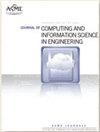数据驱动的锂离子电池放电容量与放电终值在线预测
IF 2.6
3区 工程技术
Q2 COMPUTER SCIENCE, INTERDISCIPLINARY APPLICATIONS
Journal of Computing and Information Science in Engineering
Pub Date : 2023-11-06
DOI:10.1115/1.4063985
引用次数: 0
摘要
摘要锂离子电池的健康状态监测和性能预测对电动汽车等电力系统的可靠性和安全性至关重要。然而,实时估计电池的放电容量和放电终值(EOD)仍然是一个挑战。很少有关于电池容量退化与EOD之间关系的研究报道。本文提出了一种新的数据驱动方法,将卷积神经网络(CNN)和双向长短期记忆(BiLSTM)模型相结合,利用在线状态监测数据预测放电容量和EOD。CNN模型提取电压、电流和温度测量之间的长期相关性,然后估计放电容量。BiLSTM模型提取状态监测数据中的短期依赖关系,并利用CNN预测的容量作为附加输入,预测每个放电周期的EOD。通过考虑放电容量,BiLSTM模型能够利用电池的长期健康状态来提高其短期性能的预测精度。结果表明,该方法能有效、准确地实现在线流量估计和排爆预测。本文章由计算机程序翻译,如有差异,请以英文原文为准。
Data-Driven Online Prediction of Discharge Capacity and End-of-Discharge of Lithium-ion Battery
Abstract Monitoring the health condition as well as predicting the performance of Lithium-ion batteries are crucial to the reliability and safety of electrical systems such as electric vehicles. However, estimating the discharge capacity and end-of-discharge (EOD) of a battery in real-time remains a challenge. Few works have been reported on the relationship between the capacity degradation of a battery and EOD. We introduce a new data-driven method that combines convolutional neural network (CNN) and bidirectional long short-term memory (BiLSTM) models to predict the discharge capacity and the EOD using online condition monitoring data. The CNN model extracts long-term correlations among voltage, current, and temperature measurements and then estimates the discharge capacity. The BiLSTM model extracts short-term dependencies in condition monitoring data and predicts the EOD for each discharge cycle while utilizing the capacity predicted by CNN as an additional input. By considering the discharge capacity, the BiLSTM model is able to use the long-term health condition of a battery to improve the prediction accuracy of its short-term performance. We demonstrated that the proposed method can achieve online discharge capacity estimation and EOD prediction efficiently and accurately.
求助全文
通过发布文献求助,成功后即可免费获取论文全文。
去求助
来源期刊
CiteScore
6.30
自引率
12.90%
发文量
100
审稿时长
6 months
期刊介绍:
The ASME Journal of Computing and Information Science in Engineering (JCISE) publishes articles related to Algorithms, Computational Methods, Computing Infrastructure, Computer-Interpretable Representations, Human-Computer Interfaces, Information Science, and/or System Architectures that aim to improve some aspect of product and system lifecycle (e.g., design, manufacturing, operation, maintenance, disposal, recycling etc.). Applications considered in JCISE manuscripts should be relevant to the mechanical engineering discipline. Papers can be focused on fundamental research leading to new methods, or adaptation of existing methods for new applications.
Scope: Advanced Computing Infrastructure; Artificial Intelligence; Big Data and Analytics; Collaborative Design; Computer Aided Design; Computer Aided Engineering; Computer Aided Manufacturing; Computational Foundations for Additive Manufacturing; Computational Foundations for Engineering Optimization; Computational Geometry; Computational Metrology; Computational Synthesis; Conceptual Design; Cybermanufacturing; Cyber Physical Security for Factories; Cyber Physical System Design and Operation; Data-Driven Engineering Applications; Engineering Informatics; Geometric Reasoning; GPU Computing for Design and Manufacturing; Human Computer Interfaces/Interactions; Industrial Internet of Things; Knowledge Engineering; Information Management; Inverse Methods for Engineering Applications; Machine Learning for Engineering Applications; Manufacturing Planning; Manufacturing Automation; Model-based Systems Engineering; Multiphysics Modeling and Simulation; Multiscale Modeling and Simulation; Multidisciplinary Optimization; Physics-Based Simulations; Process Modeling for Engineering Applications; Qualification, Verification and Validation of Computational Models; Symbolic Computing for Engineering Applications; Tolerance Modeling; Topology and Shape Optimization; Virtual and Augmented Reality Environments; Virtual Prototyping

 求助内容:
求助内容: 应助结果提醒方式:
应助结果提醒方式:


